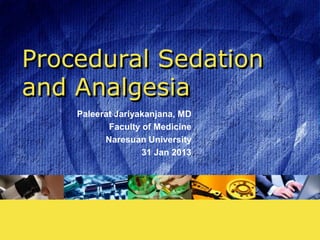
Procedural sedation and analgesia
- 1. Procedural Sedation and Analgesia Paleerat Jariyakanjana, MD Faculty of Medicine Naresuan University 31 Jan 2013
- 2. Procedural sedation administration of sedatives or dissociative anesthetics induce depressed level of consciousness maintaining cardiorespiratory function little or no patient reaction or memory Procedural sedation and analgesia (PSA) addition of agents to reduce or eliminate pain
- 5. Sedation Level Minimal sedation procedures that require patient cooperation and those in which pain is controlled by local or regional anesthesia Procedures: lumbar puncture, sexual assault examinations, simple fracture reductions, abscess I&D Agents: nitrous oxide, midazolam, fentanyl, pentobarbital, low- dose ketamine
- 6. Sedation Level Moderate sedation procedures in which detailed patient cooperation is not necessary, and diminished pain reaction and muscular relaxation is desired Procedures: reduction of shoulder dislocation, thoracostomy tube insertion, synchronized cardioversion Agents: propofol, etomidate, ketamine, methohexital, an d combination of fentanyl and midazolam
- 7. Sedation Level Deep sedation procedures that are painful and require muscular relaxation with minimal patient reaction Procedures: reduction of dislocated hip Agents: same as moderate sedation, but with larger doses
- 9. History and Comorbidities: ASA Patient Assessment Procedural Urgency
- 10. Patient Assessment Hx: fasting state, prior experiences with PSA or anesthesia, current medications, and allergies PE: potentially difficult airway or cardiorespiratory problems
- 11. Patient Assessment Routine laboratory studies: not necessary Directed ancillary testing airway abnormalities, infections, advanced age, hepatic or renal disease, dehydration, fever, or hypovolemia
- 13. Fasting State
- 14. Number of Physicians Needed 2 physicians 1. perform sedation and monitor patient 2. perform procedure minimal & moderate levels of sedation 1 emergency physician administering sedation and performing procedure
- 15. Equipment equipment for airway management and resuscitation defibrillator reversal agents IV access not required for minimal sedation equipment for IV access should be immediately available
- 17. Interactive Monitoring: by dedicated observers Mechanical Monitoring
- 20. Preprocedure Pain Management The administration of morphine or fentanyl for pain control before the start of PSA will provide the patient with analgesia during PSA.
- 21. Preprocedure Pain Management PSA should begin after last dose of analgesic has been given and has reached its peak affect 3-5 minutes for IV morphine 2-3 minutes for IV fentanyl
- 22. Supplemental Oxygen during Procedural Sedation and Analgesia administration of supplemental oxygen can delay recognition of hypoventilation
- 23. Sedation Management 1. patient has been evaluated 2. appropriate sedation target level is selected 3. monitoring modalities are applied 4. preparations are made for possible adverse events 5. PSA
- 24. Sedation Management Once the patient has achieved the target sedation level, the actual procedure may begin.
- 25. SEDATION AGENTS
- 26. Nitrous Oxide can be used alone for minimal sedation or as adjunct with IV medications for moderate sedation
- 27. Midazolam sole agent for minimal sedation can be combined with opioid for moderate or deep PSA Adverse side effects mild cardiovascular depression, and hypotension can arise when this agent is given to patients who are hypovolemic paradoxical agitation
- 28. Fentanyl easily titratable when used alone for minimal sedation can be used in combination with midazolam for moderate and deep PSA
- 29. Methohexital best used for brief moderate and deep sedation joint dislocation reduction Adverse side effects respiratory depression
- 30. Pentobarbital excellent agent for minimal sedation for neuroimaging in children
- 31. Ketamine state of dissociation profound analgesia, sedation, and amnesia both analgesic and anxiolytic properties only sedative agent that typically preserves patient's ventilatory effort and has minimal effect on blood pressure
- 32. Ketamine Adverse side effects hypersalivation laryngospasm, vomiting emergence reactions mild agitation to recurrent nightmares and hallucinations increases intracranial pressure avoid in patients with head injuries increase intraocular pressure avoided in patients with eye injuries or glaucoma
- 33. Etomidate rapid onset and short duration of effect Adverse side effects less cardiovascular depression but similar respiratory depression myoclonic jerking suppression of adrenal-cortical axis
- 34. Propofol frequently used for moderate and deep PSA
- 35. Propofol Adverse side effects associated with fewer complications than etomidate or methohexital in patients who received multiple doses and is much easier to titrate most serious adverse effect: sudden respiratory depression and apnea hypotension C/I: allergic to eggs or soy protein
- 37. Follow-Up and Patient Instructions At the completion of the PSA procedure, patients are monitored until a return to baseline mental status. Return to a preprocedure baseline score or a score of at least 18 indicates the patient is safe for discharge.
- 39. ANY QUESTIONS?
